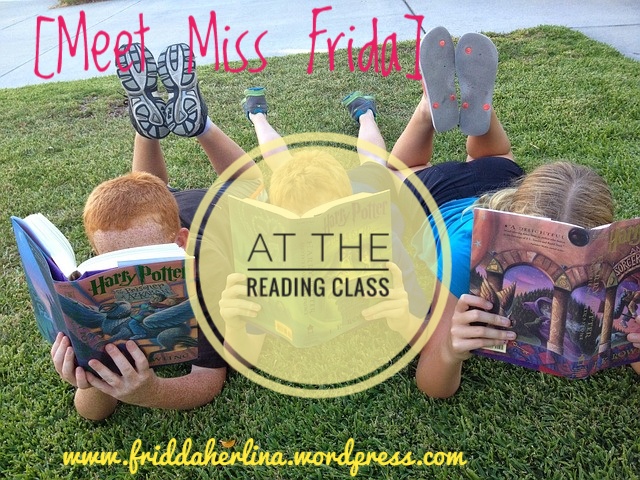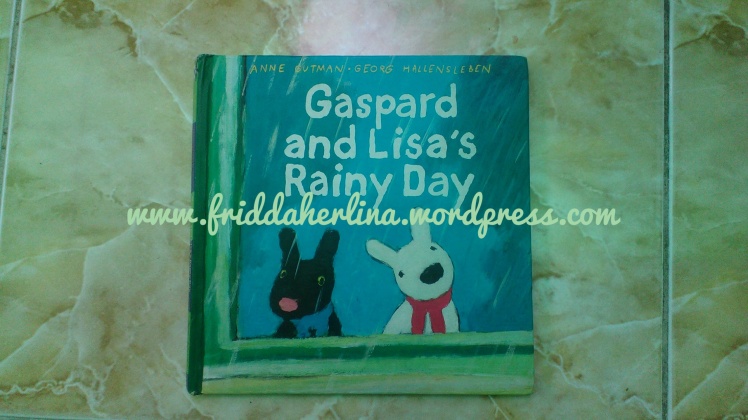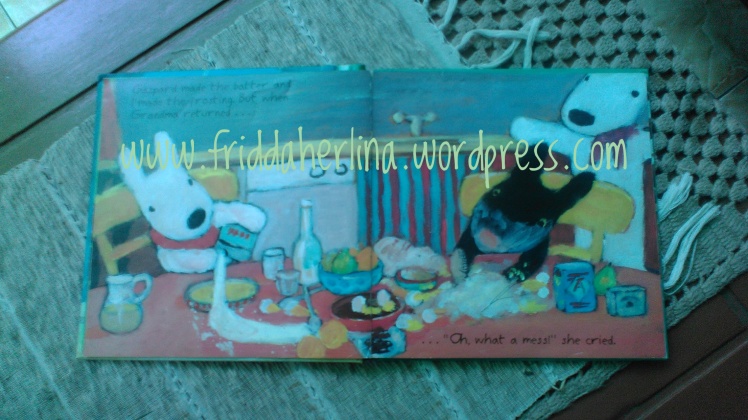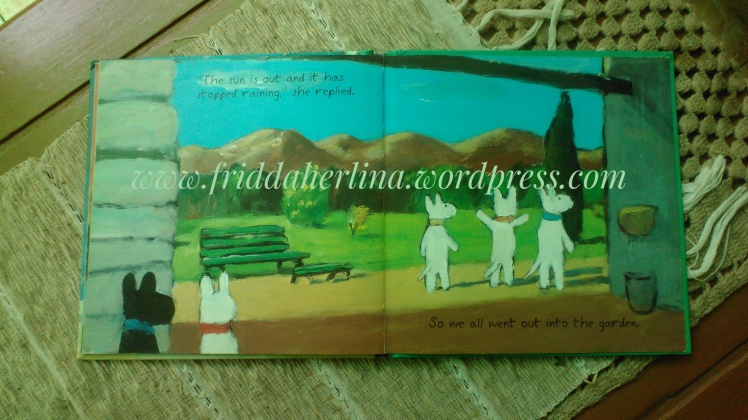
Welcome back!
Yesterday, one of my students had reading activity. She was reading Gaspard and Lisa’s Rainy Day. The story was really suited to the weather lately. It’s been raining constantly here and in your neighbourhood, too, right? Enjoy the rainy season.

Alright. As I once stated here previously, most of my students at the moment are zero-based in English. They used to communicate by using local language and Bahasa Indonesia. Therefore, learning how to pronounce the English words correctly is my main concern for them.
One of effective activities to help my students saying the words correctly is reading, of course. To me, reading activity is always personal. I always go through checking their reading one by one. They must get rid of mispronunciation. That’s the most important thing first before they learn what the story is about.
Some students who started learning with me at the age of 7 and above normally had had exposed mispronunciation. Sometimes, they tend to read the words just simply based on the letters formed, exactly like what they do in reading Indonesian words. So, it really takes their self-motivation to correct their mispronunciation. And a teacher must be there as the biggest supporter and motivator to help them.
On the contrary, it will be so much different if the students come and learn with me at their early age. By having constant practice, they can read wonderfully and fluently without any trivial mispronunciation.
Very well, then. Let’s start reading!
The following is the things you should prepare and do in your reading class with your students/kids at home: (Note: I will use the words “students, kids/children” frequently here but those words merely refer to the same meaning: young learners)
- Choose a book with a lot of pictures. Beginners are always visual. Interesting pictures may raise their curiosity to explore what the story is about. When they are curious, at least half of your job is accomplished. Just go on the next step.

- Choose a book with a simple story and fewer words to read. You should sense the struggle they experience merely for reading every single word in a sentence. Too many words will make them feel exhausted in reading. This may cause their reading motivation decreased.
- If you plan to have the same book read by your students/kids, start with picture telling about the book first. Open the page one by one and show the pictures to them. You may start having Q/A about the pictures to check how their vocabulary is. If they don’t know it or show clueless faces, of course it’s time to come to the rescue to tell them what the picture is about. Make sure they all pay attention to you and really have fun learning reading with you.

For example:
Teacher : What is this picture? (point the tree)
Student A : Tree.
Teacher : Excellent. And what is this picture? (point the bush)
Student A : (show clueless face)
Student B : I don’t know.
Teacher : Alright. (point the bush) This is the … B-OO-SH … BUSH!
And so on. And go on.
Note:
The way I explain: This is the … B-OO-SH … BUSH! is using phonics system. What is phonics? Well, perhaps some of you are already familiar with this method/system. However, I’d like to explain about it on the next blogpost. Ok?
- Have a student start reading the book. How about the others? Alright. Always keep the other students occupied. This is what to do:
- Prepare a writing exercise. Let the students (who are still waiting for reading turn) do and work it out together with their friends. Tell them to do it quietly since you’ll listen to the one who starts reading with you.
- Give them other books to read in their mind or just to see the pictures on them.
- Ask them to make a list of the pictures they see on the book. This activity is useful for their vocabulary building.
Reading a simple book with short story will take around ten minutes for each student to finish and for me to give correcction. Those three activities above (for the students who wait for their reading turns) also take ten minutes. So, it won’t take longer time for waiting. Children can be unpredictable when they feel bored waiting, right? That’s why we really need to anticipate it carefully.
This can work well if you only have two children in reading class. How about if there are more than two children? Well, if you have five children in the classroom, then each student will bear 40 minutes waiting for his/her turn or waiting for his/her other friends finish reading. And that 40 minute is too long to wait unless you have an aide teacher to assist you.
So, how do you solve this problem if you are having one-man-show class everyday?
No need to worry. You can have maximum three children for reading each day. The rest of the children will do it on the next day. So, you can save your class from boredom of waiting. You can go on your lesson plan, too. Win-win solution!
- Now, get focused on your child who’s reading now. Let him/her read a sentence first. After full stop, you give correction on the pronunciation. The sooner you give correction, the better it is. This will help your child to memorize the words faster, especially when you keep repeating them. However, if your child can read fluently enough, just give correction after he/she finishes reading for a page. Be totally quiet during his/reading and jot down the words that you’d like to highlight for correct pronunciation.
- After reading, check your child whether he/she understands the story or not. If he/she doesn’t get it, just retell the story in brief based on the pictures. Again, images always help the children to grasp better comprehension. When the whole class has done reading the same book, then you may share with them the moral values of the story.
- Mission’s accomplished.
So, what do you think about the reading steps above? I believe you can apply them with your children in the classroom or at home. Good luck!
I’ll see you in my class soon.
Lots of Love,
Frida Herlina
Thankyou sharingnya miss Frida… buku bahasa inggris di rumah masi dikit, semoga bisa pelan2 nambah buat si kecil.. oya, buku Gaspard and Lisa’s Rainy day nya bisa dibeli dimana?
Buku masih sedikit tapi kalo udah dibaca ya lebih baik lah, mbak Dewi. Semoga koleksinya bisa nambah utk si Kecil, yaa…
Aku dulu beli serial Gaspard & Lisa ini di salah satu English centre di Bintaro Tangerang pas ada obral buku second. Lumayan sih. ^^
Kalo minat, coba tengok di amazon dotcom, mbak.
Good luck!
itu cara yg sama pas dulu aku diajarin ama guru private ku :D.. Kita juga hanya berdua waktu itu mbak, jd ga bosen nunggu gilirannya… untuk anakku skr aku cuma ngajarin bicaranya dulu, krn dia blm bisa baca :)..
Wah, jadi nostalgia ya, mbak Fanny, inget2 masa belajar sama guru privat. Emang penting tuh mencegah anak2 supaya ga bosen saat nunggu giliran baca.
Yup. Saat anak mendengarkan, kita mengajarinya berbicara karena tahapannya memang alamiah kok:
√ listening
√ speaking
√ reading
√ writing
Habis ini anaknya masuk fase reading ya, mbak.
Good luck! ^^
Yes, you’re absolutely right.
I just bought some books for my kids, Gruffalo’s Child, Enid Blyton’s Amelia Jane, and some mini classic fairy tales.
The fairy tales books have lots of colorful illustrations, and my kids were very excited reading them.
For the Amelia Jane, well at first they weren’t too excited, bcs the book is full of texts. Just some illustrations and the book is not colorful. Black and white. But they then got interested after I read them some of the pages. They were interested in the story. As the result, they were reading the book by themselves. Very nice :).
Sorry for writing the comments this long, Miss Frida 🙂
Love your tips. Can’t wait to get some more 🙂
It’s very nice of you to spend your time buying and reading books to your children. I hope they really have a good time reading and become amazing readers soon.
I love reading long comments. No need to worry. ^^
Glad to know that you love the reading tips above. Thank you, mbak Dini! ^^
aku pengen lancar bahasa inggris nih mbak…ajarin dong hehe
Yuk, belajar sama2, mbak Tuty.
Kalo mau lancar jelas harus berani speaking, ya … ^^
Absolutely, reading is the best practices for influently in english *eh bener ga nih grammarnya haha
*aduk-aduk buku bacaan sambil senyum-senyum*
^^
Miss Frida, aku mau dooong kursus privat sama dirimu, bisa nggak? Online gitu Mba. Untuk speaking bisa pakai voice note di Whatsapp, yakan? 😀
Saya juga mau ikutan kalo ada 🙂
Wah, serius nih, Mbak Dini?
(bagian 2)
*matengin konsep*
Serius nih, Nyak?
*langsung bikin konsep*
Seriously?
serius,,, ikottt…. hehe langsung nimbrung.
aniwey mba, saya masih suka kesulitan mencarikan buku leraning b inggris yang bagus batita. di toko buku harganya mihil banget.. yang diskonan biasanya jarang, ataupun kalau ada ga terlalu bagus.. ada referensi ga mba nyari buku buat balita…
Hallo miss Frida. I read your blog and try to pronounciation it at the same time. And my tounge get twist on word “words”, “grasp” and “boredom”. I don’t know when i read it, my pronounciation was correct or not. But anyway nice to read your blog post. I get many new vocabulary words 🙂
Miss frida buka privat bahasa inggris donk mba.. aku suka bangett baca ini sambil belajar (google translate dibantuin) .. aku mau daftar mba klo buka privat yaa..
Hmm, Endah serius juga nih?
(bagian 3)
*proofread the concept*
Seriusss buangett… asal lokasi msh terjangkauu dan biaya juga cincaii hahahahaa…. ayoo lah mbaa bukaa kelass bahasa inggria
Wah, uni Ira ikutan serius nih? ^^
(bagian 4)
Apa kabar bumil? Semoga sehat dan lancar hingga persalinan, ya.
Selama ini referensi buku Bahasa Inggris utk anak buatku ya di toko buku. Kalo sampe ada garage sale ya pastinya jarang banget sih, ya…
Buku di TB mahal? Buku yg sasarannya anak2 memang harganya belum bersahabat buat mamanya, ya. Hahaha …
Apalagi buku impor yg full English jelas mihilnya bikin gigit jari ya, uni. 😂😂
Tinggal tungguin BBW (big bad wolf) book sale nih. Harga lumayan terjangkau pastinya. Tapi nunggunya setahun sekali lho, Uni.
Wahhh seru banget..mba frida, jadi guru anak saya dong.hahaha..semangat terus ngajarnya ya mba
Belajar sama anak2 pasti seru kok, mbak Gena. Ayo sini anaknya ikut belajar juga diajari mamanya. Hehe …
Sip. Semangat ngajar.
Makasih banyak, ya … ^^
Reblogged this on Frida Herlina and commented:
Happy reading
Happy learning
tulisannya bahasa inggris, aku jadi harus pelan-pelan bacanya, hehehe…
Kalo baca keras-keras ntar dikira khataman Quran lho, mbak.
Hahaha …
Not just for the young students, for myself too… until now I still read the English stories with intonation, haha… If in the classroom when I was still in course, usually one student read one sentence. Yes, the books just have one or two sentences in every page, for not making bored.